Watercolor with Pen (Tips and Tricks for Beginners)
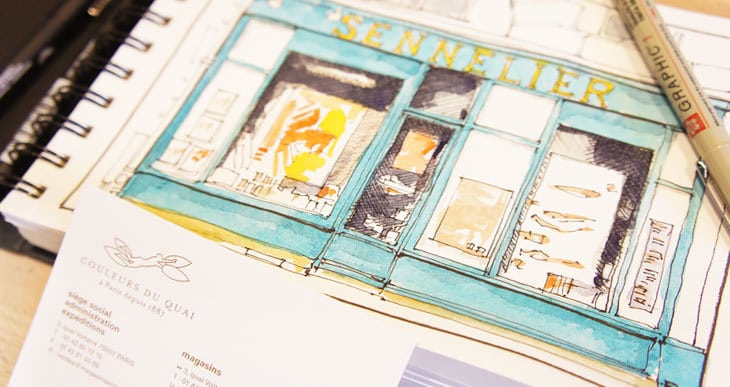
It’s one of the most delightful things I’ve ever seen.
I recently took a trip to an iconic art store in Paris – The Sennelier Art Store.
The watercolor and pen sketch you see here is a result of me playing with the art supplies I picked up ! Below I’ll give you some tips on using watercolor with ink pens for creating line and wash artwork.
Some of you may know I’m lucky enough to live near Paris in France. The Sennelier art Shop can be found at “Quai Voltaire” on the “Rive Gauche” in the heart of Paris, not far from l’Ecole des Beaux-Arts and just opposite the Louvre art museum.
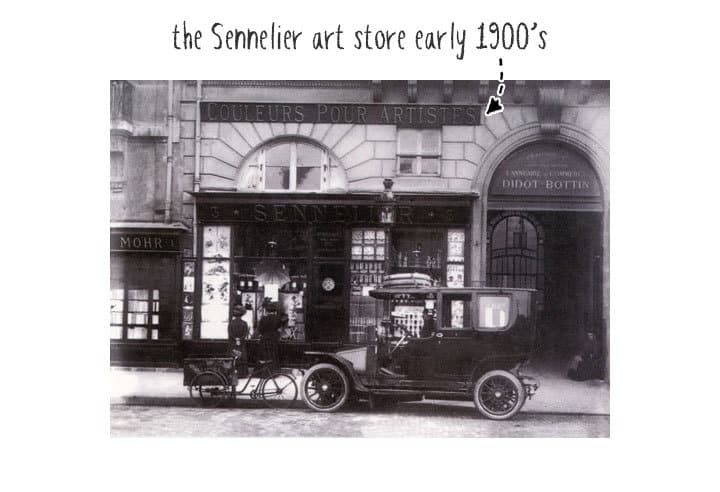
It’s not a huge store. A lot of people visit simply for the pleasure of browsing all the amazing, colorful art equipment. Imagine being surrounded by an abundance of wonderful colored pastels, paints, crayons, and pigments, and every type of brush and paper imaginable!
How can you resist ? I was like a kid in a candy store 🙂
This is the original Sennelier shop which was opened by Gustave Sennelier in 1887. This was during the 19th century impressionist art movement. At first Gustave sold paints by other manufacturers, but then he started producing his own artisanal paints at the back of the store. It’s said that artists like Cézanne and Gauguin would go hunting for paints in the neighbourhood, and if an artist couldn’t find a particular color, Gustave would create it for them.
The interior of the shop is decorated all in wood and organized like an antique drugstore with oak counters, secret drawers and tall display cases offering a huge choice of art products.
Through the magic of the internet you can take a virtual tour of the inside of this amazing shop here…
Watercolor with Pen Sketching Tips
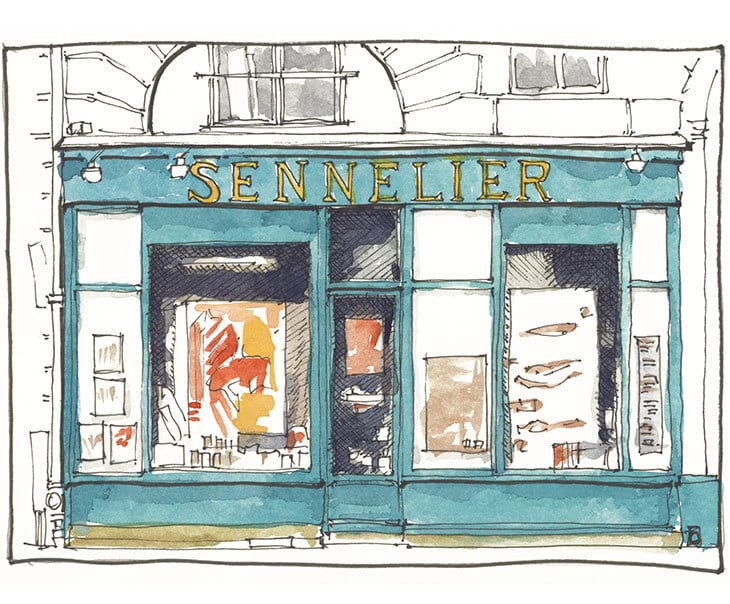
The colors used to mix that Green/blue “teal” color on the facade were Phthalo blue G.S + Phathlo green B.S. Some of the paints used in this project include:
- Phthalo Green BS – Pigment number: PG7
- Phthalo blue GS – Pigment number: PB15:3
- Pyrrol scarlet – Pigment number: PR255
- Hansa Yellow Deep – Pigment number: PY65
- Burnt umber – Pigment number: PBr7
- Paynes gray – Pigment number: Pb29/PBk9
Try this painting for yourself ! Click the button below to download the worksheet for this painting.
Watercolor and pen is a popular mixed media combination, especially for sketching and drawing on the go. This technique is also often referred to as line and wash.
Line and wash lets you combine the precision of detailed lines with the fluid and spontaneous effects of watercolors.
Below I’d like to share a few tips and common questions about working with watercolors and pens…
Can you use watercolor over a pen drawing?
Watercolors are a perfect way to add color to line drawings. A common approach is to create a simple outline of the subject in ink, without overworking the drawing or adding excessive shading or hatching.
Using the pen outline as a guide, color can be added in a loose way with watercolors. The layer of paint helps add depth and shading to the subject.
And the loose brush marks of colored paint provide a counterbalance to the hard pen lines creating a lively, illustrative look to this type of artwork.
What pens to use with watercolor
One thing you need to check is that the ink or pens you use for this technique are actually waterproof. Look at the label on your pen to see if it says something “permanent” or “indelible ink”. I usually carry around a few Pigma Micron pens which use indelible ink and are available in various widths. They’re very handy for this kind of application.
If you’re not sure whether your ink is waterproof you can test your pen on a scrap of paper then brush over the top with a quick wash of watercolor. Indelible pens dry really quickly, so you shouldn’t see any smudging when you add wet brush strokes.
Do you ink before or after watercolor ?
Many beginners ask themselves which to use first – watercolor or pen?
The truth is there’s no right or wrong way to create line and wash artwork. Although the order in which you choose to work can have an effect on the finished piece.
For example if you use a pen first you tend to end up with a more meticulous, controlled result. The pen lines are usually more dominant when you work this way round.
On the other hand if you apply ink over the top of watercolor, the result can be more energetic. You’ll be less inclined to draw the entire contour of the subject and you can just use your pens to add some texture and sharpen up a few details.
How do you paint with watercolor and pen
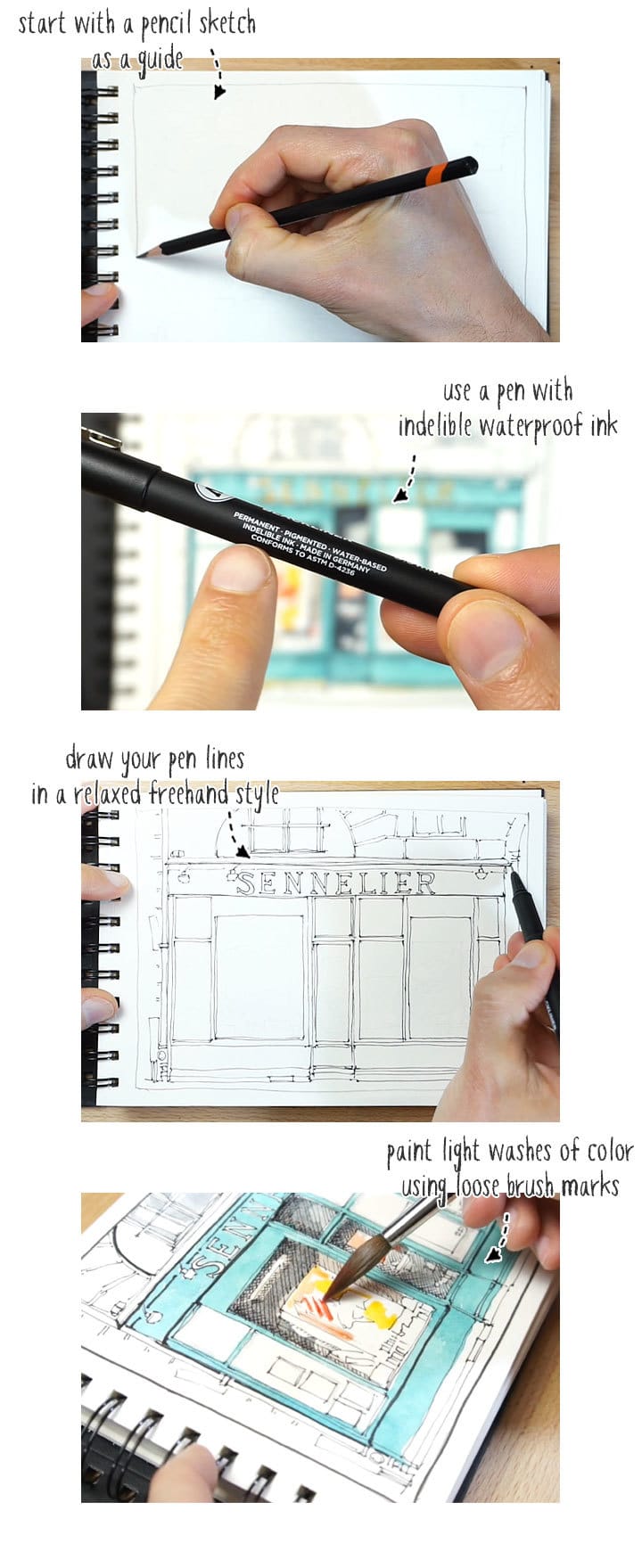
I did this sketch of the Sennelier shop front from a photo using pen and watercolor.
I started with a light pencil sketch of the facade. This doesn’t have to be detailed and will serve as a guide for your pen marks. You can always erase the pencil when you’ve completed the ink version.
Whether you choose to add lines before or after, keep in mind that less pen work often produces a better result. You’ll probably be tempted to put in more detail than necessary, but remember that you’ll also be adding a layer of paint which itself increases the sense of three-dimensions.
Try not to let your pen lines become too rigid. A lively freehand pen sketch often works better. The danger is that your finished work will look too much like a “painting by numbers”.
When the pen work is finished add some light washes of color over the top of the drawing. You don’t have to follow the pen outline accurately because the ink outline already defines the edges. Use quick loose brush marks. Let the paint dry and glaze over some more layers to deepen the values where needed or add some shadows.
Finish up by suggesting a few quick details.
Best paper for ink and watercolor
Whilst shopping at the Sennelier store I picked up this spiral bound sketchbook.
If truth be told the paper in this sketchbook isn’t best suited to watercolor painting. The weight of the paper is only 140 g/m2 or 65 lbs. Even though the watercolor washes went on quite smoothly, I was trying not to drown the surface with too much water.
You should probably look for thicker paper at about 300 g/m2 or 140 lbs.
I recommend you go for a smooth paper for line and wash creations. Look for something which says “hot press” or “smooth” on the description. This kind of surface makes it much easier for drawing with a pen. Some cold-press watercolor paper has a texture which will make pen work difficult.
I do like the spiral bound format. It lets you open up the sketchbook completely and lay it flat without the opposite page folding back and getting in the way.
The Stillman & Birn Beta series of sketchbooks uses heavy-weight paper and is ideal for this kind of thing (The Zeta series is also great for mixed media – it has slightly smoother paper than the Beta series).
Line and wash watercolor applications
This kind of pen and watercolor mixed media application is very popular for journaling and sketchbook work. There are a lot of urban sketchers who work almost exclusively like this.
Pen and ink can add a dynamic and illustrative style to watercolor paintings. Try experimenting with different amounts of pen work ranging from a few lines to suggest details up to predominantly ink artwork with a lot of contrasting black shapes and just a few splashes of color !
Have fun !
Or… Read this next: “guide to watercolor techniques”

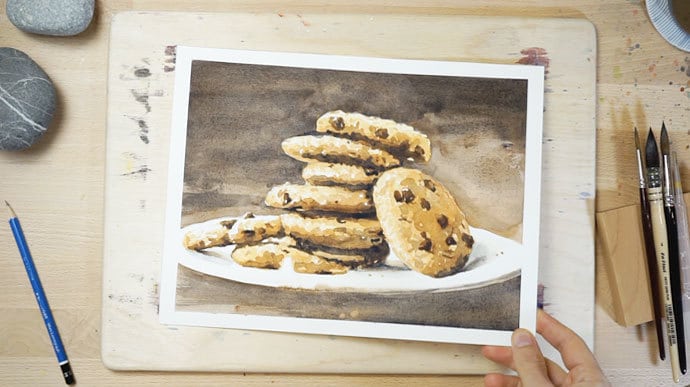
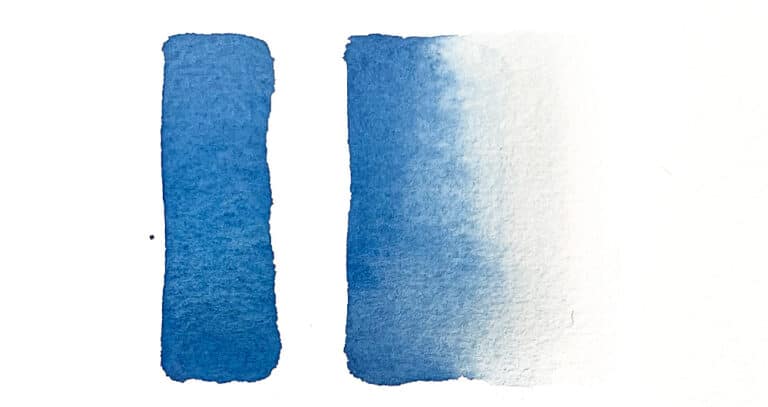
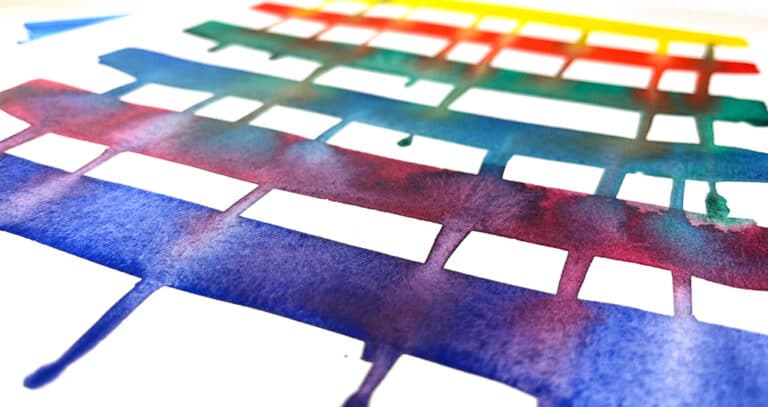
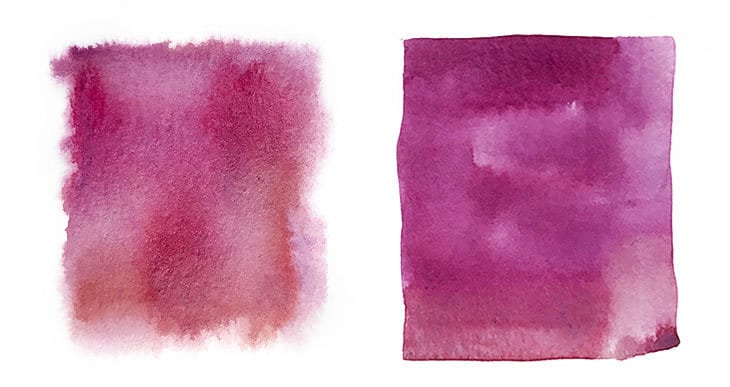
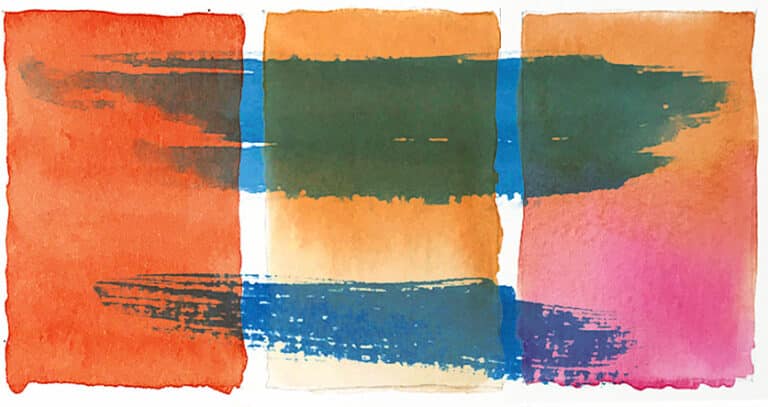
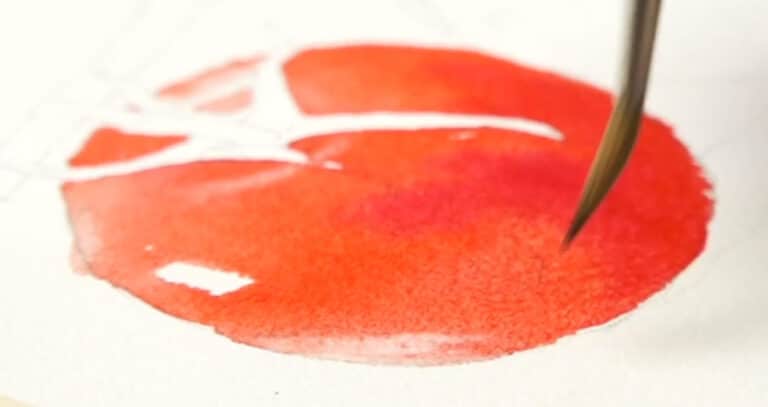
Anthony – For this Sennelier drawing, what width permanent/indelible pen do you suggest or use? Also, do you have a favorite watercolor paper you use? I am a bit confused on the watercolor paper to use with the pen. Thank you.
Hi Glenda
I use Pigma Micron pens (see the description above where it says “What pens to use with watercolor” for more details…
For the paper I recommend something which has a smooth surface (for example Hot Press watercolor paper). Again, see the section called “Best paper for ink and watercolor” above.
Hope that helps 🙂
It’s very kind of you to provide these tutorials for beginners! I could really use a couple of in-person classes but right now everything is Zoom, so I’ll have to keep practicing with your excellent tutorials. I will even take your full course at some point, after I finish another online artist’s set of exercises. Thank you!
Hi Nancy
Yes it can be tricky at the moment… but thank goodness for Zoom, eh ?
Above all have fun !
I took your course and think it is wonderful. Thank you.
John Boynton
Thank you John !
That’s very kind 🙂
Hi Anthony
Taking advantage of the theme, what do you think of Sennelier watercolor paints?
Thanks!
Hi Elson
I’ve never actually tried them. Mostly because they are honey-based paints, like the M. Graham range. The honey helps preserve the paint and also makes it more fluid. The thing is, these kind of paints never actually fully dry.
Some people like this aspect, but it can get tricky when carrying them around in a palette.
They are also a little harder to get hold of in the USA and their price is slightly more expensive – probably because of the shipping costs…
Thanks for the article. Inspired me to learn more
This is an excellent article for a beginner. As a beginner, I taken sketching classes for the last 6 months. I still feel iffy about embarking on pen and watercolor, but I just love the effect and thus article helps me see how to approach it.
Many thanks!! You lucky duck!! Living near Paris!!
Nancy Beckus, California
Hi Nancy
Thanks ! Yes i think pen and watercolor combinations can be a lot of fun 🙂
Lucky you living in sunny California 🙂 (It’s raining here today)
Take care…
Years ago I used a watercolor paper infused with fiberglass. I think it was called Excalibur. I can’t find a source for it or any similarly fiberglass infused paper. I loved the way it vibrated color and threw it back at you. Do you know where it might be found? Thank you.
Hi Robert
I think this was the Strathmore Excalibur paper. Unfortunately it looks like they don’t manufacture it anymore.
I heard it was fun to use…